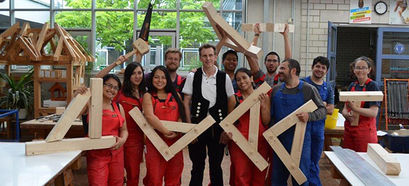Project objective
Ecuador is currently experiencing high losses in revenues due to the drop in crude oil prices. As a result, the Ecuadorian government is now more interested in foreign investments than previously. In particular, it is advertising in the areas of the manufacturing industry, oil production, energy and water management, telecommunications and mining. The potentials are vast. Qualified expert workers and engineers are needed everywhere.
The construction industry is looking for architects and construction engineers trained in sustainable, energy-efficient and earthquake-proof planning and construction. Sadly, the earthquake in April 2016 clearly demonstrated this need: 30,000 apartments were destroyed completely.
This is the focus of the ATT project. The Technical University (TU) Berlin and the Pontifical Catholic University of Ecuador (PUCE) have developed a technology transfer model aimed particularly at the construction economy and construction industry which is taking over the role of fast development aid. This is a small step on the path to sustainable, energy-efficient and earthquake-proof architecture in Ecuador.
Use of results
The model which was developed with a focus on teaching and training comprises different implementation levels. It sets out further education measures in Ecuador for architects, engineers, students, administration employees and community citizens in order to broaden knowledge of new technologies and teach about their practical application. The planned courses could also be helpful for small to medium-sized enterprises to enable them to gain a stronger position on the market with innovative technologies.
Funding announcement
Funding of the scientific and technology collaboration (STC) with developing countries in the Asia-Pacific region and the Latin America and Caribbean region 2013
Partner region / country
Ecuador
Life span
1 August 2014 – 30 Novemer 2016
Partner institutions
TU Berlin, Institute for Architecture, Supporting Structure Design and Construction
Pontifical Catholic University of Ecuador (PUCE), Faculty for Architecture
The construction of a training centre is the biggest step towards implementing the technology transfer model, which is to be created as a centre for sustainable architecture education and research in Quito. This joint project was confirmed in writing in a Memorandum of Understanding, which was signed by PUCE, TU Berlin, the Chamber of Architecture of Pichincha and the German-Ecuadorian Chamber of Industry and Commerce in April 2016.
Ecuadorian students and academics spend one week at the Berlin-Brandenburg construction industry training centre in July 2016 exploring what practical courses at the Centre for Education and Research for Sustainable Architecture could look like.
The aim was to train up to 15 PUCE students in construction industry crafts in Germany for 2-4 weeks each year and to provide them with practical skills until the Centre for Education and Research for Sustainable Architecture in Quito has been completed. This enables students to increase their practical skills competence and will help to ensure that more buildings in Ecuador will be planned and constructed as earthquake-proof in the medium and long term.
Added value of international cooperation
The ATT project links Europe with Latin America, Germany with Ecuador and TU Berlin with PUCE. On the one hand, a national network of universities multiplies the competences available; on the other hand, the project findings can become accessible to a wider group of people. Industry contacts are of key importance in the ATT project, in particular contacts with the Chamber of Foreign Trade. As such, the ATT project is also an example of “industry meeting industry”. Such direct contact reveals the demands of industry in relation to future employees.
PUCE is very much hoping to participate in an EU-funded project. As a result, the ATT project was also used to convey the requirements of a “Horizon 2020” project and to meet the national contact. The project partners are greatly welcoming the opportunity to introduce the ATT project results to a broad international audience on the occasion of the HABITAT III conference.
Outstanding results and achievements of the project
By signing the above-mentioned Memorandum of Understanding, the project partners have already taken concrete steps towards implementing the technology transfer model. In addition to measures supporting the course syllabus of the Chamber of Architects with talks by industry representatives and student training to provide practical skills, the implementation of the Centre for Education and Research for Sustainable Architecture in Ecuador is the most important measure. This would be the first centre of its kind in Ecuador as well as Latin America and as such would act as a pilot centre. And of course, as a pilot building, the building itself would be planned and constructed as a sustainable, energy-efficient and earthquake-proof building. However, full financing has not currently been secured.
Conatct
DLR Project Management Agency
European and International Cooperation
Inge Lamberz de Bayas
phone: +49 228 3821-1436
Technical University Berlin
Department Design and Structures
Prof. Dr.-Ing. Klaus Rückert
phone: +49 30 314 218 51








